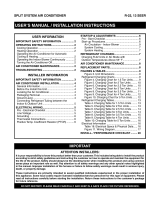
2
Important Safety Information ....................................5
Heat Pump Installation ...............................................6
General Information ...................................................6
Before You Install this Unit .........................................6
Locating the Heat Pump ............................................6
Packaging Removal ...................................................6
Ground Level .............................................................6
Connecting Refrigerant Tubing between the
Indoor & Outdoor Unit ...............................................7
Electrical Wiring ..........................................................7
Pre - Electrical Checklist ...........................................7
Line Voltage ...............................................................7
Grounding..................................................................8
Thermostat Connections ...........................................8
Startup & Adjustments ..............................................9
Pre - Start Checklist ..................................................9
Start-up Procedures ..................................................9
Air Circulation - Indoor Blower ...............................9
System Cooling ......................................................9
System Heating ......................................................9
Refrigerant Charging ..................................................9
Charging R-22 Units in AC Mode with
Outdoor Temperatures Above 55° F ........................10
Heat Pump Maintenance ..........................................10
Replacement Parts ...................................................10
Figures & Tables .......................................................11
Figure 5. Unit Dimensions ...................................11
Refrigerant Charging Charts ...................................11
Figure 6. JT5BD-018K (1.5 Ton Units) ................11
Figure 7. JT5BD-024KA (2 Ton Units) .................12
Figure 8. JT5BD-030KA (2.5 Ton Units) ..............12
Figure 9. JT5BD-036K (3 Ton Units) ...................13
Figure 10. JT5BD-042K (3.5 Ton Units) ..............13
Figure 11. JT5BD-048K (4 Ton Units) .................14
Figure 12. JT5BD-060K (5 Ton Units) .................14
Refrigerant Charging Tables - Cooling Mode ..........15
Table 4. JT5BD-018K (1.5 Ton Units) ..................15
Table 5. JT5BD-024KA (2 Ton Units) ...................15
Table 6. JT5BD-030KA (2.5 Ton Units) ................16
Table 7. JT5BD-036K (3 Ton Units) .....................16
Table 8. JT5BD-042K (3.5 Ton Units) ..................17
Table 9. JT5BD-048K (4 Ton Units) .....................17
Table 10. JT5BD-060K (5 Ton Units) ...................18
Refrigerant Charging Tables - Heating Mode ..........19
Table 11. JT5BD-018K (1.5 Ton Units) ................19
Table 12. JT5BD-024KA (2 Ton Units) .................19
Table 13. JT5BD-030KA (2.5 Ton Units) ..............20
Table 14. JT5BD-036K (3 Ton Units) ...................20
Table 15. JT5BD-042K (3.5 Ton Units) ................21
Table 16. JT5BD-048K (4 Ton Units) ...................21
Table 17. JT5BD-060K (5 Ton Units) ...................22
Electrical Information ...............................................23
Figure 12. JT5BD Wiring Diagram .......................23
Table 18. Electrical Specs & Physical Data ..........24
USER INFORMATION
INSTALLER INFORMATION
Important Safety Information ....................................3
About the Heat Pump .................................................3
Operating Instructions ...............................................3
Cooling Operation .....................................................3
Heating Operation .....................................................3
Emergency Heat........................................................3
Defrost Operation ......................................................3
Operating the Heat Pump for Automatic
Cooling & Heating .....................................................4
Operating the Indoor Blower Continuously ................4
Turning the Heat Pump Off ........................................4
Heat Pump Maintenance ............................................4
Regular Cleaning.......................................................4
Troubleshooting ..........................................................4
WARRANTY INFORMATION
A warranty certifi cate with full details is included with the
Heat Pump. Carefully review these responsibilities with
your dealer or service company. The manufacturer will not
be responsible for any costs found necessary to correct
problems due to improper setup, improper installation,
adjustments, improper operating procedure on the part
of the user, etc. Some specifi c examples of service calls
which are not included in the limited warranty are:
• Correcting wiring problems in the electrical circuit
supplying the Heat Pump.
• Resetting circuit breakers or other switches.
• Adjusting or calibrating of thermostat.




















